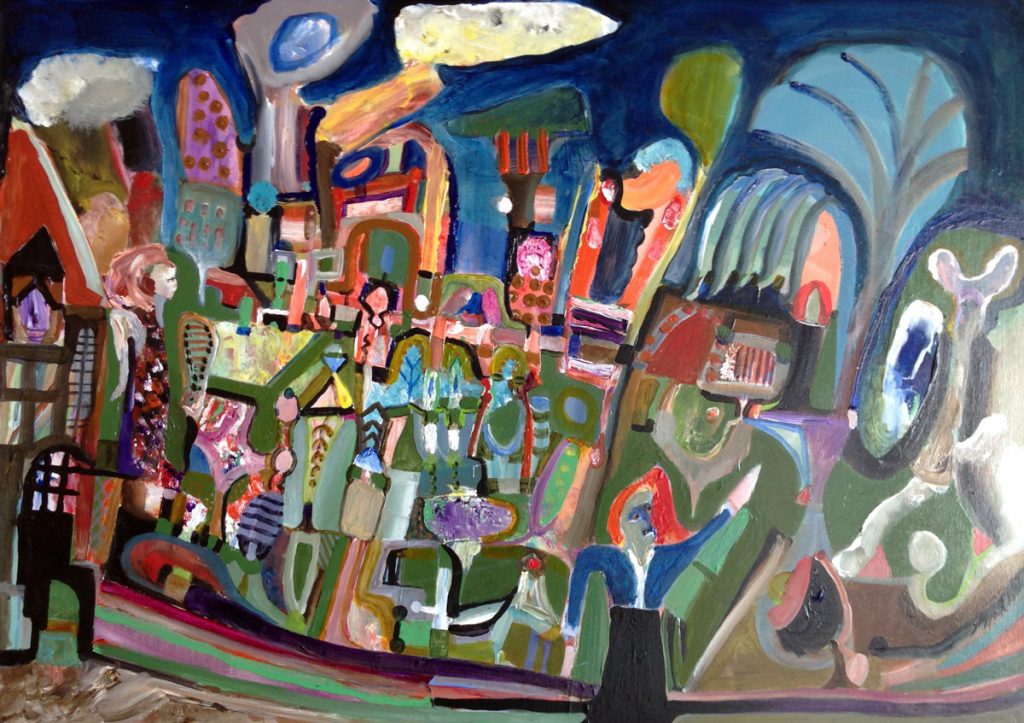By BUD JOHNS
The recent news of a possible Zen rock garden on Cottage Row brought back memories of the late Sutter Marin, the Beat era artist and poet who was a garden lover and the only Cottage Row resident I’ve known.
My wife and I live with one of Marin’s paintings, Sister, Dear Sister, There’s a Rabbit in Your Garden. After years of hearing little about him, we learned recently of “The Beat Went On: Late Works by Sutter Marin,” an exhibition featuring his work and others of his milieu at Santa Rosa’s Calabi Gallery, with a ruth weiss poetry reading and jazz accompaniment.
Marin, who had a B.A. in fine arts from San Francisco State, studied and then was an instructor at the San Francisco Art Institute. His collaborations with weiss, a German-born poet, included his 1961 solo show at the San Francisco Museum of Art (now SFMOMA) followed in 1964 by a one-person show at the de Young Museum. He won the Legion of Honor’s 1959 Phelan Award for painting, was in the Oakland Museum’s 1964 annual and had his work selected three times for Sacramento’s Crocker Museum annual.
My friendship with Sutter began in 1973 when I purchased a house on Sacramento Street. The living room needed to be painted and my late wife, the artist Judith Clancy, knowing Sutter did such jobs while cobbling together a living, suggested we hire him. He and another artist did a fine job, although Sutter objected to my salvaging a badly overgrown back yard myself rather than having him do the gardening. He relented when I told him I’d like to see some of his paintings, which led to the purchase of Sister, Dear Sister. One day I came home and Judith said Sutter had stopped by to visit, then stomped off when she commented that the rabbit looked like a snail.
A few weeks later Sutter rang the doorbell. “You were right,” he told her. “All my rabbits look like snails.” He had visited others who purchased his paintings of gardens with rabbits and viewed those in his studio, then came to apologize. Typical Sutter.
I never considered myself a patron, but seem to have become one unintentionally. Looking back, I found a 1978 print of Sutter’s drawing of an angel from an edition of 100 by Andrew Hoyem, himself a poet who began his career as a fine printer publishing Beat Generation writers. Sutter signed it to us with thanks “for being such fine artists, patrons, friends and fellow angels,” concluding “with best wishes for a great today” from “A busted angel, Sutter.”
A lanky, wiry fellow who was usually wearing blue jeans and clodhopper work shoes, Sutter was a familiar figure on Fillmore — especially from Bush Street, up past Gus Kotzbeck’s frame shop and gallery to the southwest corner of Fillmore and California, where a friend’s studio was on the second floor above a donut shop. Whenever I saw him clomping along, my first thought was of Ichabod Crane.
Twice I remember encountering Sutter and asking how things were going. He said he had some new paintings he thought I’d like. I didn’t especially like them, but sensed that he was broke, so I asked if he had some older paintings I could see. Each time I really liked one, exuberant and affordable: Birth of the Blues (the only blue is a small patch in the middle of a field of earth colors) and Little Egypt. Both are now in the Oakland Museum collection.
Another time Sutter called and said he thought I should see the work of a friend who was returning to Portland after visiting here. I fell in love with a small oil — a clove of garlic in a clamshell — which my wife and I still have. The price was $45, just enough for gas for his return drive. Art and gas both cost less in those days.
Sutter’s poems were usually self-published, poorly printed or even handwritten. But The Door Opens and Out Comes In was nicely designed and printed. Many of its 113 short whimsical poems have illustrations by Sutter, who aptly described the book in his inscription of my copy: “Viewers of insanity trying to go straight.”
Sutter died in 1985 at age 59, withering away of a disease that was just becoming diagnosed: AIDS.
“The Beat Went On: Late Works by Sutter Marin” will be exhibited through December 31 at the Calabi Gallery in Santa Rosa.
Filed under: Art & Design, Locals





